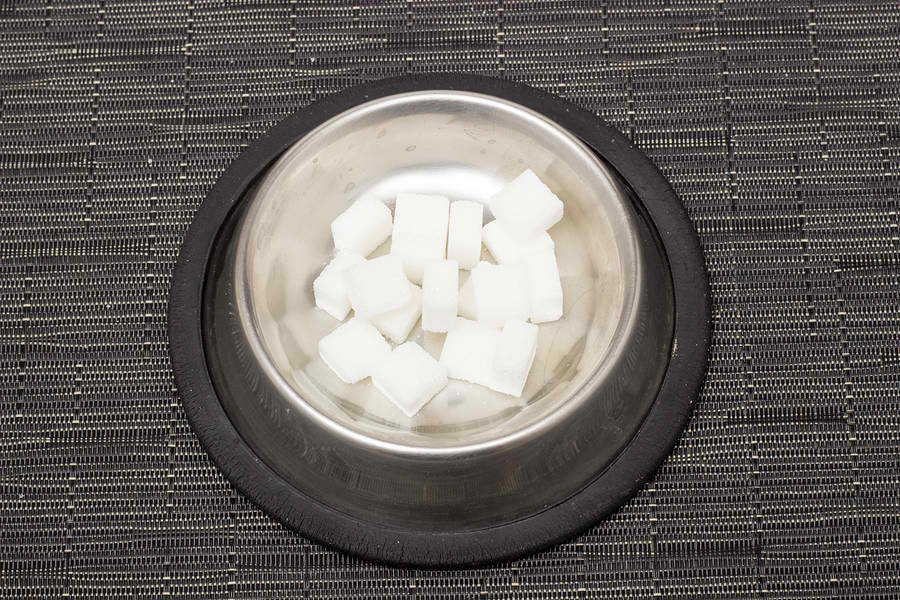
This post may contain affiliate links. We are compensated for referring customers to our affiliate partners.
The ingredients in your dog’s food matter. With some many different dog food brands on the market, it is hard to know what the best food is for your dog. You can research dog food reviews and dog food comparison charts online, but since you don’t know the agenda of the reviewer, the only real way to know that you are buying the best dog food is by reading the label.
The healthiest ones use only natural ingredients with no fillers or unnecessary additives. Sometimes it is hard to know what these ingredients are so we’ve put together a list of ingredients to avoid in dog food.
Sweeteners
Added sugar is a no brainer, if a dog food has sugar listed in the ingredients it is definitely not a great product. Sugar is a cheap way to make dog food more enticing because it improves the flavor. However, too much sugar in a dog’s diet can lead to a range of problems from weight gain to diabetes and does not benefit their overall health.
Also, it’s important to know sometimes sugar additives are disguised. Some common names for sugars are fructose, sucralose, and dextrose. There are also artificial sugars found in some dog foods. The most common is propylene glycol. Propylene glycol is used both to sweeten the food and retain the moisture. Some of the possible side effects of too much propylene glycol consumption are liver and heart failure, as well as damage to the nervous system. If you see any of these ingredients you should move on to the next brand.
Chemical Preservatives
Dog foods do not share the same regulation and protection as human foods. So dog food manufacturers can add preservatives that are banned for human consumption. For example BHT and BHA are common preservatives found in dog foods, but they are not allowed as an additive in human food in most countries. BHT and BHA are carcinogens and are linked to cancer. If it is something not fit for humans, then you certainly should not feed it to your dog. Also look for nitrates and sulfates, as they are commonly used to preserve and flavor meat but they have some really bad side effects.
There are a number of natural preservatives that you should look for instead. Natural preservations can be herb-based like rosemary, mustard, or garlic. They can also be microbiol like acidophilus or lactocin. Finally there are vitamin preservatives like vitamin C also called citric acid or vitamin K also called tocopherols. These natural preservatives are a much better way to preserve food and the health of your dog.
Animal By-Products
Animal byproducts are always listed as a byproduct so they are easy to spot. Animal byproducts are the leftover products from meat product. They are unregulated and can contain everything from beaks and feathers to organs and bones. They are not legally classified as meat. So if the ingredients list says “chicken by product” but not “chicken” there probably is not chicken meat in the food. Animal byproducts are also not allowed for human consumption, so again, they are questionable for your dog.
Other form of animal byproducts include “meals.” Meat meal, bone meal, and blood mean, and also “animal fat” are the byproduct of the processing of animal byproducts. The remains of the animals from meat production, including parts like the hooves, teeth, and fur, are ground, cooked, and then dried. The fat is separated and used as the additive animal fat and the rest is ground and used as an additive. These products also do not contain meat and have questionable nutritional value. Meals and animal fat are also not added to human food.
Fillers
Fillers are foods that have no nutritional value but add bulk to a product. Some fillers rice hulls or dried beet pulp sound innocuous or even like they may contain some nutritional value. However, fillers do not add nutritional value and a dog food with lots of fillers is not only less nutritious but a waste of money.
Another common filler is cellulose or powdered cellulose. Cellulose is made from finely ground wood, so essentially it is paper shreds or sawdust. Cellulose is added also to prevent clumping and maintain the moisture balance. However it has zero nutritional value and it can also cause digestive problems like gas. If you see fillers on the label of your dog food, not only is it an unhealthy choice for your dog, but it is a huge waste of money for you.
Grains
No there is some debate on whether or not grains are healthy for your dog. However, there is a consensus that if your dog food contains grains it should be whole grains and not processed grains. There is also some concern about corn and corn meal. Corn is a cheap ingredient and many dog foods use it as their primary ingredient. You want to make sure the primary ingredient in your dog food is meat and not corn. The best way to know this is by reading the ingredients list. The ingredients list is in order of volume. So if corn is the first ingredient, it means it is the main ingredient. If the first ingredient is meat, then that is the main ingredient.
The ingredients in your dog’s food matter. The best things to look for are whole foods like meat, vegetables, fruits, and if so inclined whole grains. However even foods that are advertised as healthy and natural can contain some pretty bad ingredients like sugars, preservatives, animal by products, and fillers. So it is really important to understand these ingredients and then look for them in the ingredients list.
